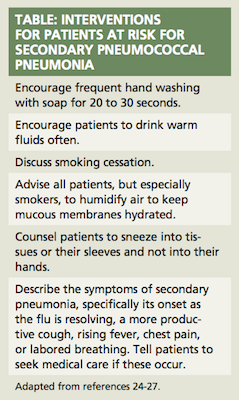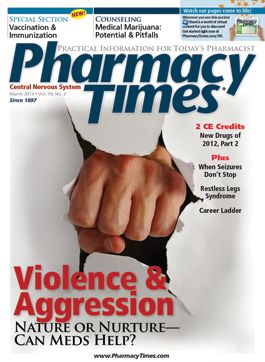Publication
Article
Pharmacy Times
The Good Fight: Preventing Influenza & Pneumococcal Pneumonia
Author(s):
Vaccination is crucial for older adults and patients with chronic disease.
Vaccination is crucial for older adults and patients with chronic disease.
Vaccine Synergy, an Important Preventive Measure
Despite the availability of vaccines, a comorbid condition—invasive pneumococcal disease (IPD) with influenza—is the eighth-leading cause of death in the United States.1 Both infections are vaccine preventable. How could this be?
Influenza, the Compromiser
Influenza, a viral infection highly contagious when infected people cough or sneeze, is one of winter’s most dreaded illnesses. Its increased prevalence in winter is unexplained, but some research indicates the virus survives and is transmitted more efficiently in cold temperatures.2 Some experts consider it a “hit-and-run” pathogen because it so often leads to secondary bacterial coinfection or exacerbation of underlying chronic diseases.3 This makes it difficult to determine its exact incidence. Influenza and its complications cause an average of about 20,000 deaths in the United States alone. Ninety percent of these deaths occur in people 65 years or older.4
Flu pandemics, which occur about every 30 years, are a public health nightmare. In the 1918-1919 Spanish flu pandemic, the death toll reached 20 to 40 million globally, with approximately 500,000 of these in North America. If an influenza pandemic of the same magnitude and severity occurred to day, an estimated 51 to 81 million people would die worldwide.4
A bout of flu this year confers no immunity for the next season. Every year, different disease-causing strains from influenza virus families A, B, or C circulate. Type A viruses infect several species including humans, are responsible for most cases of influenza, and tend to have a greater virility in adults. Type B and C viruses infect humans only, and Type B viruses are a greater problem in children.5 Table 1 describes typical symptoms. Although often blamed for gastro-intestinal (GI) upset or diarrhea, influenza rarely causes GI symptoms. (GI symptoms are usually due to other organisms such as rotavirus, Salmonella, Shigella, or Escherichia coli.3)
Vaccination can prevent much of the morbidity associated with influenza. In healthy people younger than 65 years, it can prevent approximately 70% to 90% of illness. In community-dwelling elders, influenza vaccine is 30% to 70% effective in preventing hospitalization. In elderly residents of long-term care facilities, the vaccine can be 50% to 60% effective in preventing hospitalization or pneumonia and 80% effective in preventing death.8
Pneumococcal Pneumonia, the Exploiter
A case of influenza opens the door and invites oxygen-robbing respiratory infection, specifically pneumonia. When this occurs, the pneumonia is deemed “secondary.” It is especially likely and potentially fatal in the elderly, the very young, and patients who have chronic conditions. Pneumonia’s possible causes are many, including bacterial, fungal, mycoplasm, tubercular, or viral infection; chemical exposure; or aspiration of food, liquid, gases, or dust. The most common cause of community-acquired pneumonia is Streptococcus pneumonia,9 and it is one of several pneumococcal diseases—S. pneumonia also causes meningitis, bacteremia, otitis media, and sinusitis.10 It, too, is vaccine preventable to a great extent by using the pneumococcal polysaccharide vaccine 23 (PPV23) or either the pneumococcal conjugate vaccine 7 (PCV7) or the pneumococcal conjugate vaccine 13 (PCV13).
In terms of effectiveness, controversy still surrounds the PPV23 vaccine, which covers 10 strains not included in the PCV13 that account for 15% of IPD in the United States.11 Research conducted in the last decade has been inconclusive about its effectiveness. A much-cited 2003 Cochrane review determined PPVs do not appear to reduce pneumonia or death incidence in adults with or without chronic illness, or in the elderly (55 years and older). They reported that PPVs do reduce the incidence of other invasive pneumococcal diseases among adults and the immunocompetent elderly (55 years and older) and deaths related to these specific infections.12 Other studies have found different results, and various studies’ methodological flaws may be the explanation. It is clear that PPV23 does prevent much IPD, but not pneumonia specifically.13
Influenza-Pneumoccocal Pneumonia Coinfection, the Disaster
Coinfection of influenza (flu) and pneumococcus is common during flu epidemics, and is responsible for a different symptom set and up to 25% of all influenza-related deaths.14-16 Researchers have documented temporal relationships between influenza activity and bacterial pneumonia, and have shown that the relationship between influenza A and bacterial agents is synergistic.17,18
Vaccination against both influenza and pneumococcal pneumonia also appears to be synergistic. In a large cohort of elders vaccinated against both influenza and pneumococcal disease, researchers found the incidence of all-cause pneumonia was 29% less and mortality was 35% less than in elders who had just one or neither vaccination. Vaccinated study participants also had shorter hospital stays.19 Other studies have shown significant savings from direct medical costs when patients receive both vaccines.20-23

Elders and patients who have chronic disease need both pneumococcal and influenza vaccinations. Pharmacists can identify older adults and patients who have chronic conditions, and urge them to be vaccinated. Many people have embraced the growing practice of receiving annual influenza vaccinations at community pharmacies—a practice we need to encourage and expand.
Pharmacist-immunizers are well positioned to identify at-risk patients and encourage vaccination against pneumoccocal disease at the same time. The Table describes other important interventions.
Ms. Wick is a visiting professor at the University of Connecticut School of Pharmacy and a freelance clinical writer.
References:
- Heron M, Tejada-Vera B. Deaths: leading causes for 2005. Natl Vital Stat Rep. 2009;58:1-97.
- Centers for Disease Control and Prevention (CDC). Update: influenza activity--United States, September 30-November 24, 2012. MMWR. 2012;61:990-993.
- Simonsen L, Viboud C. The art of modeling the mortality impact of winter-seasonal pathogens. J Infect Dis. 2012;206:625-627.
- Murray CJ, Lopez AD, Chin B, Feehan D, Hill KH. Estimation of potential global pandemic influenza mortality on the basis of vital registry data from the 1918—20 pandemic: a quantitative analysis. Lancet. 2006;368:2211-2218.
- Pleschka S. Overview of Influenza Viruses [published online November 3, 2012]. Curr Top Microbiol Immunol.
- Viasus D, Paño-Pardo JR, Pachón J, et al; Novel Influenza A(H1N1) Study Group of the Spanish Network for Research in Infectious Diseases (REIPI). Pneumonia complicating pandemic (H1N1) 2009: risk factors, clinical features, and outcomes. Medicine (Baltimore). 2011;90:328-336.
- Viasus D, Cordero E, Rodríguez-Baño J, et al; Novel Influenza A (H1N1) Study Group of the Spanish Network for Research in Infectious Diseases (REIPI). Changes in epidemiology, clinical features and severity of influenza A (H1N1) 2009 pneumonia in the first post-pandemic influenza season. Clin Microbiol Infect. 2012;18:E55-E62.
- DiazGranados CA, Denis M, Plotkin S. Seasonal influenza vaccine efficacy and its determinants in children and non-elderly adults: a systematic review with meta-analyses of controlled trials. Vaccine. 2012;31:49-57.
- Ishiguro T, Takayanagi N, Yamaguchi S, et al. Etiology and factors contributing to the severity and mortality of community-acquired pneumonia. Intern Med. 2013;52:317-324.
- Song JY, Nahm MH, Moseley MA. Clinical implications of pneumococcal serotypes: invasive disease potential, clinical presentations, and antibiotic resistance. J Korean Med Sci. 2013;28:4-15.
- Pilishvili T, Lexau C, Farley MM, et al. Sustained reductions in invasive pneumococcal disease in the era of conjugate vaccine. J Infec Dis. 2010;201:32-41.
- Annunziata K, Rak A, Del Buono H, Dibonaventura M, Krishnarajah G. vaccination rates among the general adult population and high-risk groups in the United States. PLoS One. 2012;7:e50553.
- Assaad U, El-Masri I, Porhomayon J, El-Solh AA. Pneumonia immunization in older adults: review of vaccine effectiveness and strategies. Clin Interv Aging. 2012;7:453-461.
- Simonsen L. The global impact of influenza on morbidity and mortality. Vaccine. 1999;17(suppl 1):S3-S10.
- Bhat N, Wright JG, Broder KR, Murray EL, Greenberg ME, Glover MJ. Influenza-associated deaths among children in the United States, 2003—2004. N Engl J Med. 2005;353:2559-2567.
- Dear K, Holden J, Andrews R, Tatham D. Vaccines for preventing pneumococcal infection in adults. Cochrane Database Syst Rev. 2003;(4):CD000422.
- Brundage JF. Interactions between influenza and bacterial respiratory pathogens: implications for pandemic preparedness. Lancet Infect Dis. 2006;6:303-312.
- McCullers JA. Insights into the interaction between influenza virus and pneumococcus. Clin Microbiol Rev. 2006;19:571-582.
- Jefferson T, Rivetti D, Rivetti A, Rudin M, Di Pietrantonj C, Demicheli V. Efficacy and effectiveness of influenza vaccines in elderly people: a systematic review. Lancet. 2005;366:1165-1174.
- Hanage WP, Finkelstein JA, Huang SS, et al. Evidence that pneumococcal serotype replacement in Massachusetts following conjugate vaccination is now complete. Epidemics. 2010;2:80-84.
- Christenson B, Hedlund J, Lundbergh P, Ortqvist A. Additive preventive effect of influenza and pneumococcal vaccines in elderly persons. Eur Respir J. 2004;23:363-368.
- Weaver M, Krieger J, Castorina J, Walls M, Ciske S. Cost-effectiveness of combined outreach for the pneumococcal and influenza vaccines. Arch Intern Med. 2001;161:111-120.
- Lin CJ, Zimmerman RK, Smith KJ. Cost-effectiveness of pneumococcal and influenza vaccination standing order programs. Am J Manag Care. 2013;19:e30-e37.
- Taitel M, Cohen E, Duncan I, Pegus C. Pharmacists as providers: targeting pneumococcal vaccinations to high risk populations. Vaccine. 2011;29:8073-8076.
- Veltri K, Yaghdjian V, Morgan-Joseph T, Prlesi L, Rudnick E. Hospital emergency preparedness: Push-POD operation and pharmacists as immunizers. J Am Pharm Assoc (2003). 2012;52:81-85.
- Rees S, Stevens L, Drayton J, Engledow N, Sanders J. Improving inpatient pneumococcal and influenza vaccination rates. J Nurs Care Qual. 2011;26:358-63.
- Pilisuk T, Goad J, Backer H. Vaccination delivery by chain pharmacies in California: results of a 2007 survey. J Am Pharm Assoc (2003). 2010;50:134-139.







